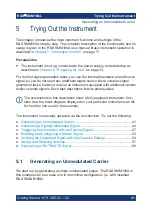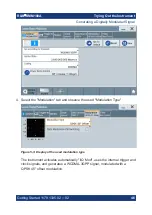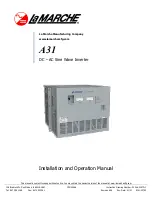
Trying Out the Instrument
R&S
®
SMM100A
53
Getting Started 1179.1335.02 ─ 02
depicts the location of the connectors and explains the con-
nection as principle. In practice, you would rather "substitute" the analyzer by
a DUT, like a base station (BS). Other than in the example, the DUT can be
the source for the reference signal. Instead of using an external trigger
source, the DUT can also send, for example, a frame trigger signal to the
R&S
SMM100A. The R&S
SMM100A acts still as the signal source.
2. Use suitable cables to connect the
R&S
SMM100A to the signal analyzer or the DUT.
Upon the receiving of an external trigger event, the R&S
SMM100A starts the
signal generation and then generates a continuous signal. An "Arm" stops the
signal generation. A subsequent trigger event causes a restart of the signal
generation.
To learn more about this topic, refer to:
●
Chapter "Baseband Trigger Signals" in the user manual
●
Chapter "Global Connectors" in the user manual
5.4
Enabling and Configuring a Marker Signal
Test setups often require that an external device is synchronized to the generated
data stream. For this purpose, the R&S
SMM100A can output marker signals (or
markers) also to the generated signal. The R&S
SMM100A provides several reg-
ular marker signals and marker signals specific to the firmware option. With suita-
ble marker settings for instance, you can mark slot or frame boundaries or mark
the start of a particular modulation symbol.
This example extends further the configurations performed in
erating a Digitally Modulated Signal"
on page 44. We assume a default connector
This test setup requires one oscilloscope, like the R&S
®
RTO, as additional equip-
ment.
1. In the block diagram, select "Block Diagram > Baseband > Misc > Custom
Digital Mod > Marker" tab.
2. Select "Marker Mode > Marker 1 > Pulse" and "Divider = 32".
Enabling and Configuring a Marker Signal
Summary of Contents for SMM100A
Page 1: ...R S SMM100A Vector Signal Generator Getting Started 1179133502 Version 02 S2...
Page 6: ...Contents R S SMM100A 6 Getting Started 1179 1335 02 02...
Page 12: ...Key Features R S SMM100A 12 Getting Started 1179 1335 02 02...
Page 26: ...Preparing for Use R S SMM100A 26 Getting Started 1179 1335 02 02 Switching On or Off...
Page 40: ...Instrument Tour R S SMM100A 40 Getting Started 1179 1335 02 02 Rear Panel Tour...
Page 86: ...Contacting Customer Support R S SMM100A 86 Getting Started 1179 1335 02 02...
















































